Agilite just released a brand new version of their popular K19 plate carrier that has a series of upgrades. Check out the video below that explains the new features:
Agilite just released a brand new version of their popular K19 plate carrier that has a series of upgrades. Check out the video below that explains the new features:
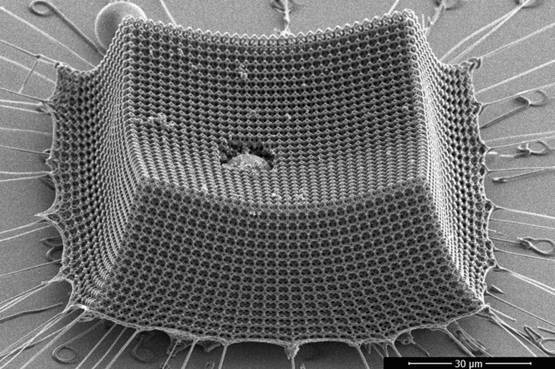
RESEARCH TRIANGLE PARK, N.C. — Army-funded research identified a new material that may lead to lightweight armor, protective coatings, blast shields and other impact-resistant structures.
Researchers at the U.S. Army’s Institute for Soldier Nanotechnologies at the Massachusetts Institute of Technology, Caltech and ETH Zürich found that materials formed from precisely patterned nanoscale trusses are tougher than Kevlar and steel.
In experiments, the ultralight structures, called nanoarchitectured materials, absorbed the impact of microscopic projectiles accelerated to supersonic speeds.
“Increasing protection while simultaneously decreasing the weight that soldiers carry is an overreaching theme in our research,” said Dr. James Burgess, ISN program manager for the U.S. Army Combat Capabilities Development Command, known as DEVCOM, Army Research Laboratory. “This project is a really good example of such efforts where projectile energy absorption is nanostructured mechanism based.”
The research, published in Nature Materials, found that the material prevented the projectiles from tearing through it.
“The same amount of mass of our material would be much more efficient at stopping a projectile than the same amount of mass of Kevlar,” said Dr. Carlos Portela, assistant professor of mechanical engineering at MIT, the study’s lead author.
The researchers calculate that the new material absorbs impacts more efficiently than steel, Kevlar, aluminum and other impact-resistant materials of comparable weight.
“The knowledge from this work…could provide design principles for ultra-lightweight impact resistant materials [for use in] efficient armor materials, protective coatings, and blast-resistant shields desirable in defense and space applications,” said co-author Dr. Julia R. Greer, a professor of materials science, mechanics, and medical engineering at Caltech, whose lab fabricated the material.
Nanoarchitected materials are known to feature impressive properties like exceptional lightness and resilience; however, until now, the potential for additional applications has largely been untested.
“We only know about its response in a slow-deformation regime, whereas a lot of their practical use is hypothesized to be in real-world applications where nothing deforms slowly,” Portela said.
To help fill this vital knowledge gap, the research team set out to study nanoarchitected materials undergoing fast deformation, such as that caused by high-velocity impacts. At Caltech, researchers first fabricated a repeating pattern known as a tetrakaidecahedron—a lattice configuration composed of microscopic struts—using two-photo lithography, a technique that uses a high-powered laser to solidify microscopic structures in photosensitive resin.
To test the tetrakaidecahedron’s resilience to extreme, rapid deformation, the team performed experiments at MIT using the ISN-developed laser-induced particle impact array. This device aims an ultrafast laser through a glass slide.. As the laser passes through the slide, it generates a plasma, an immediate expansion of gas that launches the particles toward the target.
By adjusting the laser’s power to control the speed of the microparticle projectiles, the researchers tested microparticle velocities within the supersonic range.
“Some experiments achieved twice the speed of sound, easily,” Portela said.
Using a high-speed camera, the researchers captured videos of the microparticles impacting the nanoarchitected material. They had fabricated material of two different densities. A comparison of the two materials’ impact response, found the denser one to be more resilient, and microparticles tended to embed in the material rather than tear through it.
To get a closer look, the researchers carefully sliced through the embedded microparticles and nanarchitectured target. They found that the struts below the embedded particle had crumpled and compacted in response to the impact, but the surrounding struts remained intact.
“We show the material can absorb a lot of energy because of this shock compaction mechanism of struts at the nanoscale, versus something that’s fully dense and monolithic, not nanoarchitected,” Portela said.
Going forward, Portela plans to explore various nanostructured configurations other than carbon, and ways to scale up the production of these nanostructures, all with the goal of designing tougher, lighter materials.
“Nanoarchitected materials truly are promising as impact-mitigating materials,” Portela said. “There’s a lot we don’t know about them yet, and we’re starting this path to answering these questions and opening the door to their widespread applications.”
The U.S. Army established the MIT Institute for Nanotechnologies in 2002 as an interdisciplinary research center to dramatically improve the protection, survivability and mission capabilities of the Soldier and of Soldier-supporting platforms and systems.
In addition to Army funding through the institute, the U.S. Office of Naval Research and the Vannevar Bush Faculty Fellowship supported the research.
By U.S. Army DEVCOM Army Research Laboratory Public Affairs
Adept Armor, a new ballistic protection design and development company focused on the commercial market, tags Laura Burgess Marketing to help create brand awareness.

Carrollton, Texas (July 2021) – A new armor system engineering firm, Adept Armor, has signed Laura Burgess Marketing (LBM) to represent their public relations and media efforts.
Adept Armor is a company focused on providing civilians, private security, and rescue with state-of-the-art ballistic armor protection. Using leading-edge alloys, metals, and polymers to design and produce body armor, helmets, and other protective gear, Adept Armor’s products offer superior ballistic protection in innovative materials and designs to meet modern needs.
“It is always exciting to get a ringside seat on a new company and product launch,” Laura Burgess, president of Laura Burgess Marketing, said. “Adept Armor is truly a new paradigm in body armor companies, with a focus on the civilian market and really innovative products that are founded on Adept Armor’s highly technical and experienced team’s designs.”
LBM will work with Adept Armor to launch company news, new products, and social media platforms.
Adept Armor recently launched website introduces the public to their first line of body armor featuring a multi-curved titanium alloy plate that is bonded to a high-performance polyethylene backer, creating a body armor plate that has the strength and multi-hit capability traditional in steel body armor with the lighter weight and performance abilities of ceramic-composite body armor.
Interested in armor materials, systems, test methods and current threats? Check out Adept Armor’s incredible knowledgebase of information and glossary. Learn more about Adept Armor on their new website or follow them on Facebook.
Stow, OH-based ShotStop Ballistics has announced the release of what they describe as an “ultra-light” Level IV HA Armor Piercing Advanced Body Armor Plates.
According to ShotStop,
“What makes this an industry shattering announcement is the unprecedented weight for Level IV protection, weighing in at 4.5 lbs (2.0 kg) with a low profile of 0.9″ thick, these multi-curve, stand-alone, multi-hit plates provide the lightest armor-piercing protection in the world. The plate will provide the operator comfort, better mobility, and all the confidence to carry out their mission whether they are Military, Special Forces, SWAT, or Law Enforcement.”
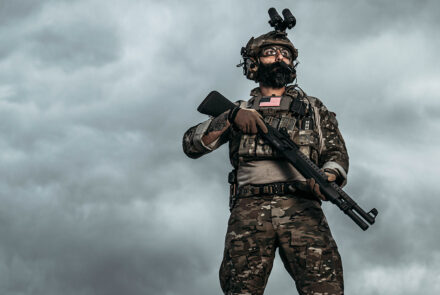
Jason Henkel, Director of Operations at ShotStop, says, “Protection is absolutely ShotStop’s top priority, but being able to increase comfort, mobility, and advanced unique applications really differentiate this launch from others. Our new Level IV plate is positioned to dramatically change the way in which personal protection can be utilized in various environments and circumstances.”

The new plates are available in the following Shooter Cut and SAPI cuts and the following sizes:
6” x 6” x .9”
8” x 10” x .9”
8.75” x 11.75” x .9”
9.5” x 12.5” x .9”
10″ x 12″ x .9″
11″ x 14″ x .9″
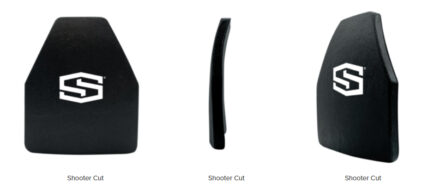
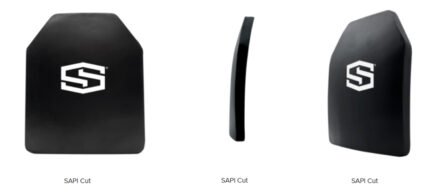
Read the remainder of the release after the video.
Threat Level Protection
The National Institute of Justice (NIJ) states that level IV armor must stop a single hit of 7.62MM AP. ShotStop’s HA Level IV ballistic body armor, made with patented Duritium® technology, is multi-hit and can defeat special threats including: 5.56x45mm 55 grain ball (M193), 7.62x39mm PS ball (MSC), 7.62x51mm 149 grain M80 FMJ, NATO M855 (SS109) 5.56x45mm 62 grain steel core (SS109), M855 A1, 7.62×54mmR Dragunov, and 7.62x63mm M2 AP.
The plate is currently pending testing to be listed with the NIJ.
Ounces Equal Pounds, and Pounds Equal Pain
Improving on the current HS Level IV model plate, ShotStop reduced the weight from 5.3 lbs to 4.5. When pounds equal pain for the operator, every ounce matters. Typical heavy body armor increases the amount of pressure on the joints, causing fatigue, pain and long-term medical issues. ShotStop’s Level IV plate gives the operator maximum mobility and while reducing weight-displacement injuries which are typical from heavy steel or ceramic Level IV plates.
“The accumulated reduction in knee load for a 1-pound loss in weight would be more than 4,800 pounds per mile walked,” says researcher Stephen P. Messier, PhD, of Wake Forest University. So, if a person was carrying 10 pounds less weight, “each knee would be subjected to 48,000 pounds less in compressive load per mile walked.”
Industry-Leading 10-Year Warranty
Along with the armor-piercing protection, the HA1RF3MC model comes with an unprecedented 10-Year warranty, translating to an unusually low total cost of ownership for the highest quality level IV plate available. Standard level IV ceramic body armor is only warrantied for 5 years. Unlike ceramic plates, which can crack when dropped, ShotStop’s proprietary composite plates do not need MRI/x-rays to monitor the plate’s integrity throughout the industry-leading warranty period. ShotStop’s plates can take a beating from everyday wear & tear and mishaps like drops, without ever compromising protection.
What is Duritium?
Duritium is a portfolio of technologies including a proprietary formula of Polyethylene fibers or ultra-high molecular weight polyethylene. These polyethylene fibers are woven and stacked by a computer navigated layering process at particular angles which elevate the ability of the armor system to more efficiently diffuse kinetic energy during ballistics impact. The stacked polyethylene is then vulcanized under 5000 lbs. per sq. inch presses while going through various high heat and cold cycles to form the base of the Duritium body armor.
Depending on the threat level requirement, the armor system can then be combined with ShotStop’s proprietary alloy composite which offers even further weight and thickness savings compared to other competitive armor options, especially at the higher threat levels.
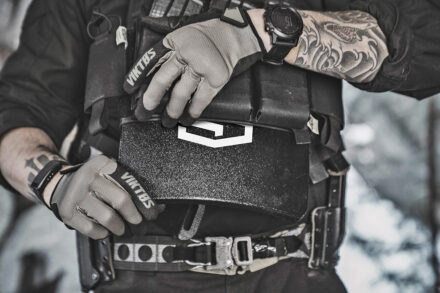
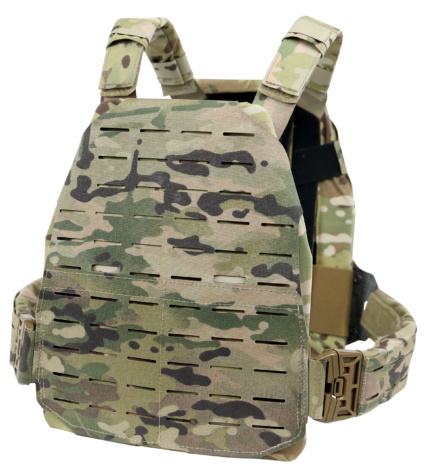
In this latest iteration of the PlateFrame, S&S Precision increases comfort and modularity. Other than the S&S PF-M, it is the only armor carrier system with the patented (US 10605574) adjustable Auto-Fit Cummerbund and thoracic load-bearing technology. By using a single layer of semi-rigid composite material with laser-cut MOLLE/PALS slots, they were able to keep the overall weight to just over one pound to further increase performance.
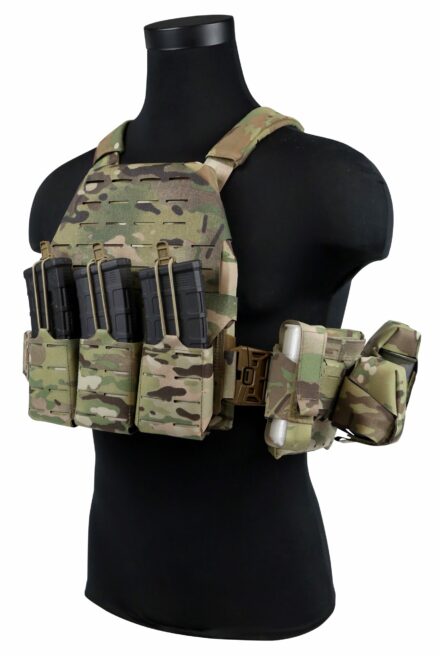
The PF-R’s Auto-Fit Cummerbund comes in four different sizes and when properly fitted helps to distribute the weight of the operator’s loadout across their entire torso while still allowing for expansion of the chest and lungs.
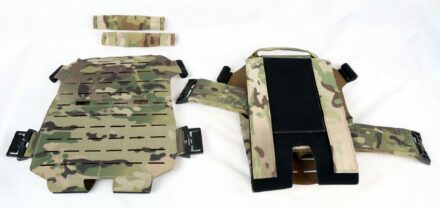
Once removed from the box it is simple to configure. Additionally, the PF-R is compatible with the Operator System Suite (OSS) Redux which is a series of minimalistic and practical set of pouches which can be used with any of S&S Precision’s carriers or standard MOLLE/ PALS webbing systems. This series is constructed of light-weight, hydrophobic material that is durable, long-lasting and will shed water to reduce weight in wet environments.
Available in MultiCam, Black, Tan and Toadvine, the PF-R is available to accommodate a wide variety of plates. Check the site for current offerings.
www.sandsprecision.com/plate-frame-and-accessories/plateframes/plateframe-redux